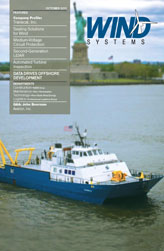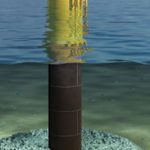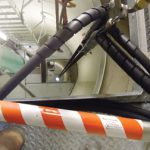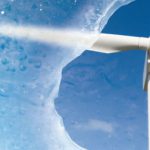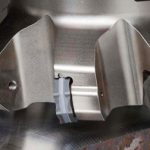In the United States today the total wind fleet stands at approximately 41,000MW, creating enough clean energy to supply 10 million homes. In the first part of this year 1,100MW of new capacity was installed. At the same time about half the power consumed in the United States today is generated with coal. Nuclear is next at 20 percent, natural gas at 18 percent, and hydroelectric at 7 percent. Together, renewable sources like wind and solar make up only 2 percent of all the power generated in the United States. As wind power is the fastest growing sector in the global power generation industry it is projected to continue in the same trajectory.
Our collective demand for power continues to increase, and in the next 20 years our demand for energy is expected to double. To meet our ever increasing energy needs, new and improved alternative and renewable energy sources are becoming an extremely viable solution verses the past. Wind power is a critical part of the solution.
Robust, Reliable Circuit Protection
Simply put, wind power is remote and variable. Wind resources are often far from significant markets and plant output varies with wind conditions, creating a variety of public and electrical industry challenges. As wind projects need to be at the site of the wind source, the generation location is often remotely located from the electric load, and there is often reliance on long-distance transmission. Wind farms require a complex collection of equipment that needs to work together efficiently so as to generate electricity and transmit it to the grid. Industry leading manufacturers are engineering equipment able to address the unique needs of wind power applications. Figure 1
Medium-voltage circuit breakers with enhanced capabilities and industry leading protective and monitoring devices make it easier to get generated power into the system, so that it can be distributed and used. While addressing the requirements of wind turbine applications there are circuit breakers engineered to improve uptime, reliability, and sustainability while enhancing safety.
Circuit Protection for Wind
Fundamentally, wind turbines convert the energy captured from wind into electricity. A turbine captures wind’s kinetic energy and converts it into electricity through the action of blades, which are connected to a generator. The generator converts the blade’s rotational movement into electricity at low or medium voltage. Typically this voltage for small- and mid-sized wind applications ranges from 500 to 700 volts (V), although utility-scale turbines are capable of generating thousands of volts. From the generator, electricity flows through heavy electric cables to a substation transformer, which increases the voltage of the electric power to a distribution voltage. The distribution voltage is usually in the thousands of volts range; a common distribution voltage range is 15 kilovolts (kV) to 38 kV. From the transformer, the distribution power flows to a collection point, where the power can be combined with other turbines. In some cases the electricity is utilized locally, though it is typically sent to a substation where the voltage is increased to a high transmission level for efficient delivery to faraway cities and facilities. Figure 2
Eight Key Characteristics
With the right equipment and support, wind farms are able to lower lifecycle costs. Remotely located equipment should be selected based on its reputation for minimal downtime, operational longevity, extended maintenance requirements, and extra performance capabilities.
As the design and operation of wind plant power systems has unique challenges, electrical equipment manufacturers can help address these concerns. Intermittent power generation can pose problems for the supporting electrical equipment, which may not be designed to cater to these notable variations. Evaluating and monitoring processes of all electrical systems within wind plants should focus on a range of issues, including: the unpredictable nature of wind power, remote locations, frequent generator operation, voltage regulation, frequency considerations, thermal and fault issues, system dynamics including capacitor operations, reactive power management, event analysis, and system and equipment performance.
Specifically, medium-voltage vacuum circuit breakers can address the rigorous requirements of wind turbine applications and improve uptime, reliability, and sustainability, while enhancing safety. Specific considerations for specifying such circuit breakers include:
1) Proven Technology: Incorporating proven vacuum interrupting technology, medium-voltage circuit breakers should be designed to reliably switch normal and high-stress currents. A global manufacturer, Eaton is applying more than 80 years of innovation and experience to its circuit protection solutions for wind power applications.
2) Green and SF6 Free: Avoid use of Sulfur Hexafluoride (SF6), which poses environmental and safety concerns. SF6 is a colorless, non-flammable gas often used in circuit breaker applications above 38kV. It is finding its way into lower voltages in the U.S. in the form of as insulated switchgear (GIS), which uses SF6 for its insulation system. In the case a leakage occurs during system operation, or if cleanup is required after equipment failure, toxic byproducts can be produced, and SF6 poses safety concerns. Further, dismantling and disposing of circuit breakers that rely on SF6 can result in similar exposure. If there is excessive moisture, toxic byproducts can be produced during the course of normal arc interruption. Today you do not need to rely on SF6 gas for insulation materials. A leading power management company, Eaton developed industry leading vacuum interrupting technology that requires no cooling or ventilation systems, and avoids the use of SF6. Eaton has been solid-insulation technology in a wide range of applications for more than 50 years.
3) Compact Footprint: Using compact circuit breakers can mean that the switchgear footprint is compact as well, by enabling the voltage transformers to be in the top compartment of the switchgear. For example, Eaton VCP-Wind breakers allow the assembly to be mounted above the breaker to save space.
4) Remote Racking for Enhanced Safety: Remote racking devices connect to breakers and allow personnel to insert and remove them while standing outside the arc flash protection boundary. Eaton engineered remote racking devices to increase distance between the operator and the front of the switchgear lineup during racking operations, putting 25 feet between the operator and the switchgear.
5) Protected Components Reduce Maintenance: Pole units that are encapsulated protect high-voltage components from the environment. The Eaton VCP-Wind breaker is engineered to require reduced maintenance over the product lifecycle.
6) Easy Access: A direct roll-in configuration, like that of Eaton VCP-Wind breakers, makes it easier to handle and relocate the breaker.
7) Customized Design: Circuit breakers engineered for wind applications can be customized to accommodate specific installations with the right accessories, making it easier to integrate the breaker into a switchgear design. For example, Eaton engineered:
• Spouts accommodate the mounting of six sets of current transformers per phase;
• Distinct latch positions for disconnect, test and enclosure;
• Coding pins so that only breakers of the correct ratings can be inserted into the enclosure;
• Trip-free interlocks prevent moving a closed breaker into or out of a the connect position;
• Self-aligning and coupling primary and secondary disconnecting devices.
8) Certified to Meet and Exceed Requirements: Since wind is relatively new to the generation market, policies, opinions, and available electrical equipment have a tendency to favor older and long-established generation techniques. Be confident your equipment is rated to meet and exceed minimum requirements. Eaton VCP-Wind circuit breakers meet American National Standards Institute (ANSI) and Institute of Electrical and Electronics Engineers (IEEE) C37.09 standards.
Eaton is investing significant resources into developing a wide range of solutions to meet the demands of the wind power industry. Building on more than 80 years of circuit breaker innovation, Eaton engineered circuit breakers to specifically accommodate for the conditions in wind power applications. Designed for wind farm collector substations, the Eaton VCP-Wind breakers help to improve system reliability, efficiency, sustainability, and enhance safety.



















